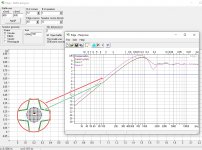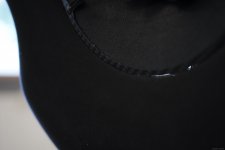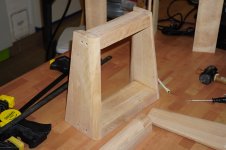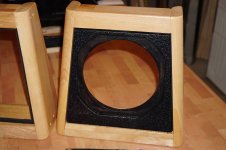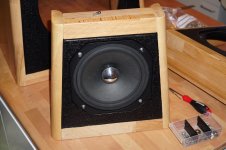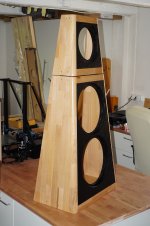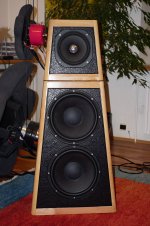It's an approximation, scroll down a bit on the page you linked to. There is the diffraction of the wave travelling around from one side to the other combined with edge diffractions. In the end they are both diffractions, a result of the same phenomena.
What ever you call them, question is how to avoid resulting peaks and minimums.
Classical diffraction at speakers

Classical diffraction at speakers

Last edited:
What I've found interesting lately is that is does seem to matter what you call them 🙂 Due to what appears to be a misunderstanding of the nature of diffractions in an OB speaker some ways of mitigating them have been too readily dismissed. Anyway you may find this thread interesting Did Siegfried Linkwitz miss a trick?
This is good thread, I had not noticed. Same challenge as I had, only in little different range.
I like the idea of smearing them off axis them rather than spreading them on axis. SL didn't think edge diffractions are detrimentally audible, may people do.
Last edited:
I checked the links and find I am familiar with that content. I had OB speakers used nearly 10 years, my current ones are 3-way, also bass part is OB down to 25 Hz.It's collected info with some own tests. U-frame dipoles or any with sort of box will have more reflections in upper band than flat baffles. Unsymmetrical walls will modify that a little, but just that. And directivity is a mess above first dipole peak too. Double drivers makes it even more dramatic.
DIY-dipole-1
H frame/ Dipole/U frame ????????
H-U frame woofers
Subwoofer Origami
Cardioid bass
etc.
But there is no any direct information that spreading dipole peaks and minimums with U-frame asymmetric rear part is not possible.
I not see any reason why part of waves cannot have longer propagation path from rear end of U-frame to listening point.
If waves energy is evenly distributed over different propagation path lengths, then peaks and minimums must also be spread.
Spreading peaks and minimums is possible up to some point, but at the expense of constant dispersion. At various threads here a flower baffle has been best so far (don't remember who's it was)
kaamelis, please make a proto and measure it 360deg! I have made many protos, many of which were so poor that I didn't even save measurements! On-axis response can always be eq'd, but directivity and dipole characteristics are the real challenge!
The reasons why Linkwitz and Kreskowsky ended with 4-way construcion was based on this - usable constant dipole directivity range is max 3 octaves. Crossover LP must be before wicked things start to happen!
The most difficult range with dipoles is above 2kHz. Small cones look good in frontal hemisphere, but only nude planars make it work really well up to 6kHz.
Bass and low midrange is challenged with large Sd required to compensate for eq demand. 15-18" or 2x12-15" drivers and wide baffle or H/U frame stop working as dipole in low hundreds of Hz,
kaamelis, please make a proto and measure it 360deg! I have made many protos, many of which were so poor that I didn't even save measurements! On-axis response can always be eq'd, but directivity and dipole characteristics are the real challenge!
The reasons why Linkwitz and Kreskowsky ended with 4-way construcion was based on this - usable constant dipole directivity range is max 3 octaves. Crossover LP must be before wicked things start to happen!
The most difficult range with dipoles is above 2kHz. Small cones look good in frontal hemisphere, but only nude planars make it work really well up to 6kHz.
Bass and low midrange is challenged with large Sd required to compensate for eq demand. 15-18" or 2x12-15" drivers and wide baffle or H/U frame stop working as dipole in low hundreds of Hz,
Spreading peaks and minimums is possible up to some point, but at the expense of constant dispersion. At various threads here a flower baffle has been best so far (don't remember who's it was)
Mattes? https://www.diyaudio.com/forums/full-range/249448-torus-2.html#post6378658
Another who seems to have too readily dismissed the potential of the torus.
PS, I'm still waiting for Richie to get back with the promised measurements of the polars of his L-frames, he also mentioned doing a video on the subject
Last edited:
My current OB are active, DSP filtered and compensated, bass is U-frame and -6 db/octave fall is analog compensated, mid+high is MTM on triangular baffle. But I find bass to mid integration is not very good and I am looking better solution, but still in MTM configuration.
Are flower baffle best as they are symmetrical?
What can be flower baffle equivalent in U-frame form?
Are flower baffle best as they are symmetrical?
What can be flower baffle equivalent in U-frame form?
Ein bisschen mehr aus dipole H-frame. Rudolf helped me a lot way back then!
Dipolplus - Alles über offene Schallwände
Dipolplus - Alles über offene Schallwände
And here is Edge on-asis response of a round vs. wheel dipole. Check off-axis difference too, it was too much a mess to show here as overlays.
Dipolplus - Alles über offene Schallwände
Dipolplus - Alles über offene Schallwände
And here is Edge on-asis response of a round vs. wheel dipole. Check off-axis difference too, it was too much a mess to show here as overlays.
Attachments
Last edited:
I like symmetry 🙂 most OB's lack front to back symmetry but that might not matter much so long as the off axis nulls aren't skewed too much
You could fold any shape back if you want, someone here contoured the side wings.
You could fold any shape back if you want, someone here contoured the side wings.
Last edited:
Symmetry happens below first dipole null in dipoles, and without edge diffraction ripples! You just must make lowpass for each "way" appropriately! Then a multiway dipole system can reach symmetry up to 6-8kHz.
I prefer to make simulation first, for example on Akabak.kaamelis, please make a proto and measure it 360deg! I have made many protos, many of which were so poor that I didn't even save measurements! On-axis response can always be eq'd, but directivity and dipole characteristics are the real challenge!
Can you tell what can be idea behind this GR Research NX Otica design Lets see your O.B. speakers....!
As I see midrange baffle is very short on left side, probably not give low enough dipole peak.
Those are just typical AC hype, no measurements and thousands of praises. Not a real solution to a problem/challenge.
One more MTM OB from GR Research https://i1.wp.com/parttimeaudiophile.com/wp-content/uploads/2019/06/ES000318-e1559667571203.jpg
There seems like cutout is partially made because tweeter?
There seems like cutout is partially made because tweeter?
After this video Do Audiophile Cables Matter? Here's PROOF! - YouTube for me it is hard to believe he know what he is talking about.
There was this response to the video, basically same as I've been preaching
Gerrit Govaerts
The U-frame can be used as long as you stay both under the cavity resonance and the D/lambda<<0.5 constraint (with D=dipole distance , lambda=wavelength ) . But also consider that a U-frame can migrate to a cardioid response instead of a figure of 8 dipole response. Adding a side wing will solve the cavity resonance problem , hower it does not address the increased dipole distance compared to a baffle with the same frontal area without a wing . This will lower the frequence of the first dipole peak very significantly and thus decrease the useable range of the driver if you want constant directivity and well behaved off-axis response.
Gerrit Govaerts
The U-frame can be used as long as you stay both under the cavity resonance and the D/lambda<<0.5 constraint (with D=dipole distance , lambda=wavelength ) . But also consider that a U-frame can migrate to a cardioid response instead of a figure of 8 dipole response. Adding a side wing will solve the cavity resonance problem , hower it does not address the increased dipole distance compared to a baffle with the same frontal area without a wing . This will lower the frequence of the first dipole peak very significantly and thus decrease the useable range of the driver if you want constant directivity and well behaved off-axis response.
Hi,
Yes, I have built the flowers, or petal baffles. The intention was not to have a true dipole, as this clearly is not possible with an 8-inch fullrange driver, but to provide an optimal loading for the drivers with a baffle as large as possible (following Rudolf´s suggestions of not having more than 2.5 times pathlength vs. cone diameter) while avoiding any negative baffle effects. Choice of mounting and baffle material of course plays it´s role as well, but the main intention was to provide a clear, diffraction-free "flowing" shape from the central part of the driver to the rolled-off "edges" of the baffles, without any discontinouities especially between cone and baffle.
The flowers have been very time and money cosuming to build, and I have never done it a second time. A good compromise is a trapezoidal baffle with very small wings, which doesn´t perform like the flowers, but is a lot easier to build.
All the best
Mattes
Yes, I have built the flowers, or petal baffles. The intention was not to have a true dipole, as this clearly is not possible with an 8-inch fullrange driver, but to provide an optimal loading for the drivers with a baffle as large as possible (following Rudolf´s suggestions of not having more than 2.5 times pathlength vs. cone diameter) while avoiding any negative baffle effects. Choice of mounting and baffle material of course plays it´s role as well, but the main intention was to provide a clear, diffraction-free "flowing" shape from the central part of the driver to the rolled-off "edges" of the baffles, without any discontinouities especially between cone and baffle.
The flowers have been very time and money cosuming to build, and I have never done it a second time. A good compromise is a trapezoidal baffle with very small wings, which doesn´t perform like the flowers, but is a lot easier to build.
All the best
Mattes
Attachments
- Home
- Loudspeakers
- Multi-Way
- Open baffle MTM questions
